Perhaps your perception of using conifers in containers is limited to a weary topiary spiral juniper gathering cobwebs by the front door, or a young Alberta spruce dressed up in a gaudy foil pot cover and decorated with a cheap red velvet bow, as seen in every grocery store across America during the holidays. What if I told you that using conifers in containers can save you money, save you time and make a design statement at the same time?

dabah landscape designs
Conifers are versatile. They are available in a range of gold, green, blue and variegated shades, and several also change color during the winter. That means you’ll easily find something to work with your chosen color scheme. You can find tall, skinny ones; low, mounding ones; and even a few that drape over the edge of a container — they don’t always have to be the centerpiece.
Perhaps the greatest argument for considering conifers as part of your mixed container design is that they help to stretch the budget. Thrifty gardeners know that buying a young conifer (in a 4-inch quart or gallon-size pot) is a great investment.
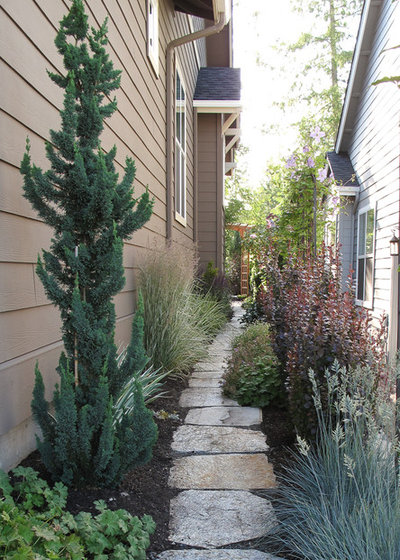
Le jardinet
I paid $20 for a 1-gallon, 20-inch-tall
Wissel’s Saguaro false cypress (
Chamaecyparis lawsoniana ‘Wissel’s Saguaro’) approximately seven years ago to use in a container garden. Today it is a wonderful vertical accent in my landscape and stands almost 8 feet tall. Finding one this size to buy would be a challenge, but the price tag of over $200 would be even more challenging. Meanwhile, as a centerpiece in my container, this quirky conifer has made putting together seasonal designs quicker and cheaper, with fewer plants to purchase and plant.
Here are some design ideas for using conifers in your containers to get year-round style.
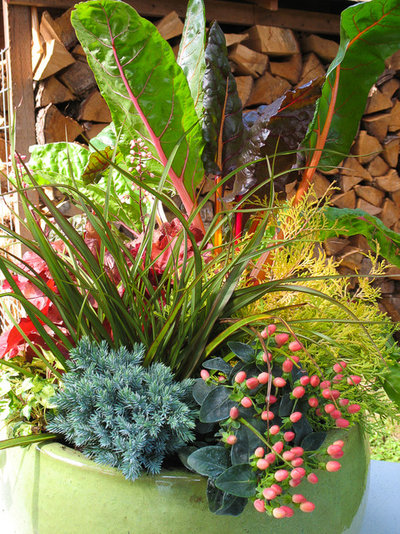
Le jardinet
Fall Conifer Container Don’t feel that you need to restrict yourself to only one conifer per container. Here a
Blue Star juniper (
Juniperus squamata ‘Blue Star’) and
Rheingold arborvitae (
Thuja occidentalis ‘Rheingold’) both add unique color and texture to a fun design that includes edible Bright Lights Swiss chard and a berried
Olivia St. John’s wort (
Hypericum sp).
Both the juniper and arborvitae are suited to the edge of the container, where they soften the edge without actually trailing. This is a short container that isn’t suited for long, trailing plants anyway.
Note how the colors of both conifers are repeated in the design.
Featured conifer 1: Blue Star juniper (in the front)
Botanical name: Juniperus squamata ‘Blue Star’
Approximate size of conifer shown: 1-quart pot
Origin: The species is native to the Himalayas and China, but Blue Star is a cultivar of
Juniperus squamata ‘Meyeri’.
Where it will grow: Hardy to -30 degrees Fahrenheit (USDA zones 4 to 8; find your zone)
Water requirement: Average to low
Light requirement: Full sun
Mature size: Up to 3 feet wide and 1 foot tall
When to plant: Year-round
Featured conifer 2: Rheingold arborvitae (in the rear)
Botanical name: Thuja occidentalis ‘Rheingold’
Approximate size of conifer shown: Quart
Origin: The species is native to the northeast U.S., but this is a garden hybrid.
Where it will grow: Hardy to -50 degrees Fahrenheit (zones 2 to 7)
Water requirement: Average to low
Light requirement: Full sun
Mature size: 3 to 5 feet tall and wide
When to plant: Year-round
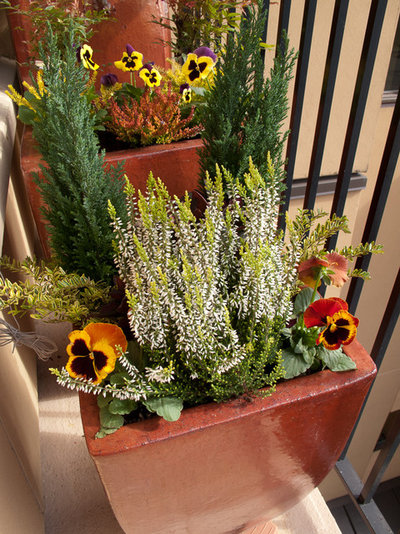
Le jardinet
I am always excited to find conifers in small sizes, and
Ellwood’s Pillar (
Chamaecyparis lawsoniana ‘Ellwoodii’) works perfectly in this modest (12-inch-diameter) container. Although it seems unusual to use two conifers in this way, the upright white
heather mimics their texture and form, adding a third element and a sense of balance.
Featured conifer: Ellwood’s Pillar Lawson’s cypress
Botanical name: Chamaecyparis lawsoniana ‘Ellwoodii’
Approximate size of conifer shown: 4-inch pot
Origin: This was discovered as a naturally occurring seedling in Great Britain in the 1920s.
Where it will grow: Hardy to -10 degrees Fahrenheit (zones 6 to 9)
Water requirement: Average
Light requirement: Full sun
Mature size: 6 to 8 feet tall and 18 inches wide
When to plant: Year-round
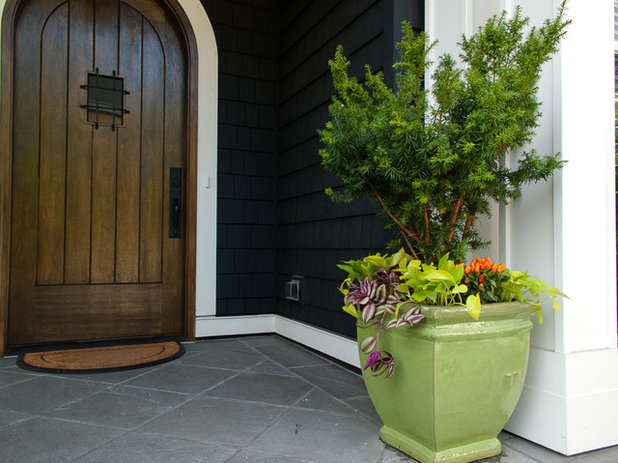
Le jardinet
From Fall to WinterIn the Pacific Northwest, our summer containers typically begin to wane toward the end of September. Occasionally, circumstances are such that they desperately need help before that, yet it is too late for summer annuals and too early for true fall and winter plants. That’s when you head off to the indoor-plant section of the nursery.
The beauty of using houseplants, especially for shaded outdoor pots, is that they immediately look fully grown. Adding some bright green trailing pothos and purple
inch plant (
Tradescantia sp) with just a splash of orange from the seasonal ornamental peppers quickly gave new life to the stalwart
Hick’s yew (
Taxus x
media ‘Hicksii’) and fresh color to the shady spot.
Featured conifer: Hick’s yew
Botanical name: Taxus x
media ‘Hicksii’
Approximate size of conifer shown: 3-gallon pot
Origin: Hick’s yew is a garden hybrid.
Where it will grow: Hardy to -30 degrees Fahrenheit (zones 4 to 7)
Water requirement: Average to low
Light requirement: Full sun to shade
Mature size: 10 to 12 feet tall and 3 to 4 feet wide in the landscape; smaller in containers
When to plant: Year-round
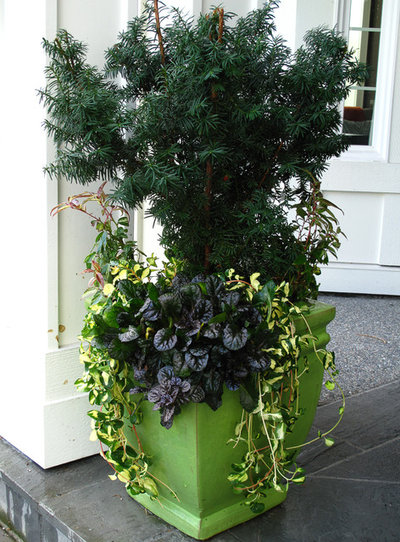
Le jardinet
As the temperature drops and those houseplants need to come inside for protection, a few tough evergreen perennials around the base of the yew offer another wardrobe change for just a few dollars. The trailing
periwinkle (
Vinca sp) can live in the container indefinitely, and the bugleweed
(
Ajuga repens) can be replaced with bright orange begonias in spring.
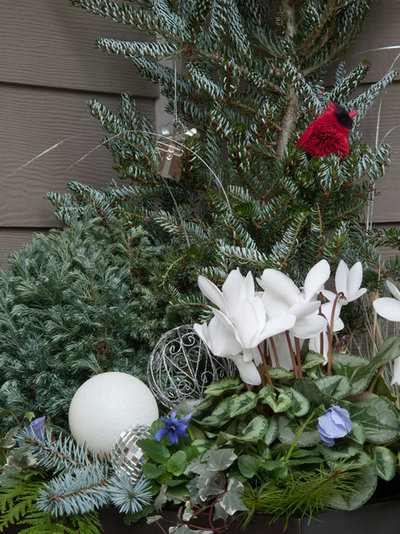
Le jardinet
Holiday SparkleTwo elegant conifers create a wintery backdrop for this holiday display.
Horstmann’s Silberlocke Korean Fir (
Abies koreana ‘Horstmann’s Silberlocke’) gives height at the back of the container and has unusual curled needles that are pure silvery white underneath. In front is
Baby Blue boulevard cypress (
Chamaecyparis pisifera ‘Baby Blue’), a low, mounding conifer with soft, curly foliage in a distinctive gray-blue — truly a beauty in both containers and the landscape.
Paired with a white
cyclamen, an assortment of cut branches from the garden and seasonal accents, this is a delightful vignette for the holidays. White
hyacinths for spring, white
caladium in summer and white mini pumpkins in fall would continue the color scheme.
Featured conifer 1: Horstmann’s Silberlocke Korean fir (also called Silberlocke fir)
Botanical name: Abies koreana ‘Horstmann’s Silberlocke’
Approximate size of conifer shown: 2-gallon pot
Origin: This is a cultivar propagated in Germany and released to the nursery trade in 1979.
Where it will grow: Hardy to -20 degrees Fahrenheit (zones 5 to 7)
Water requirement: Average
Light requirement: Full sun
Mature size: Typically to 10 feet tall and 6 feet wide in a container; taller in the landscape
When to plant: Year-round
Featured conifer 2: Baby Blue boulevard cypress (also called Baby Blue sawara cypress)
Botanical name: Chamaecyparis pisifera ‘Baby Blue’
Approximate size of conifer shown: 1-gallon pot
Origin: The species is native to Japan, but this is a garden selection.
Where it will grow: Hardy to -30 degrees Fahrenheit (zones 4 to 8)
Water requirement: Average
Light requirement: Full sun
Mature size: Typically to 6 feet tall and 4 feet wide
When to plant: Year-round
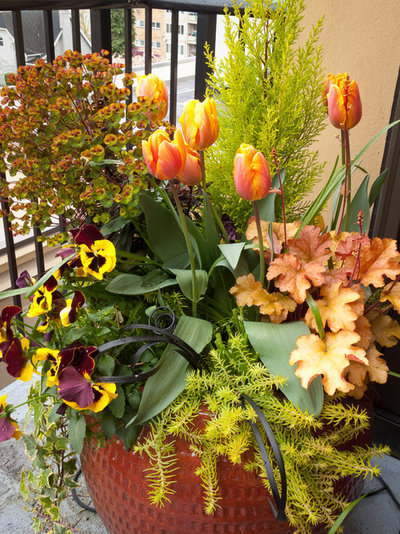
Le jardinet
SpringA bold splash of chartreuse from
Goldcrest Monterey cypress (
Cupressus macrocarpa ‘Wilma Goldcrest’) makes sure that spring starts with a shout. Yellow tones are repeated in the pansies and Angelina sedum, while the orange container,
Peach Flambe coral bells (
Heuchera ‘Peach Flambe’) and
Princess Irene tulips provide contrast. Black mondo grass (
Ophiopogon planiscapus ‘Nigrescens’) adds the finishing touch.
Summer will see a quick and inexpensive switch-out of the tulips and pansies — everything else is evergreen. The conifer can stay in this size container for approximately three years. At that point it will still be growing well, but the balance will be off as the conifer grows tall.
Featured conifer: Goldcrest Monterey cypress (also called Wilma Goldcrest Monterey cypress)
Botanical name: Cupressus macrocarpa ‘Wilma Goldcrest’
Approximate size of conifer shown: 1-gallon pot
Origin: This was developed in Holland from a genetic mutation discovered in 1987.
Where it will grow: Hardy to 0 degrees Fahrenheit (zones 7 to 10)
Water requirement: Average
Light requirement: Full sun
Mature size: Typically to 8 feet tall and 2 feet wide in a container
When to plant: Year-round
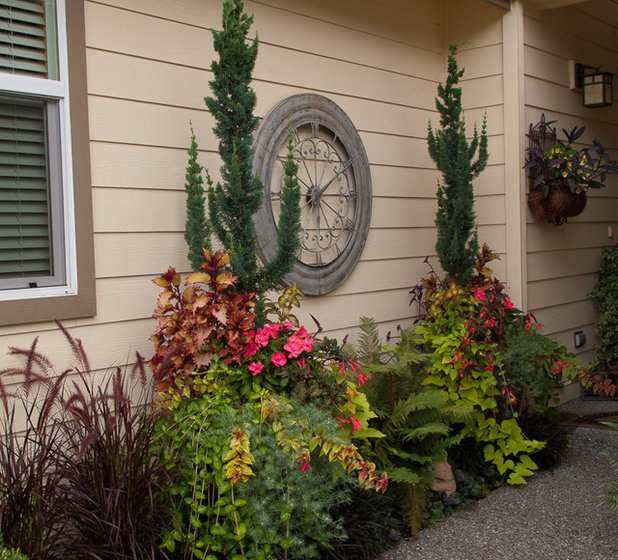
Le jardinet
SummerTall, slender conifers work especially well as the “thriller” in a mixed design, and
Wissel’s Saguaro false cypress is one of my favorites. This is a conifer with attitude, thanks to its cactus-like “arms” that beg to be hugged.
The narrow silhouette allows for plenty of additional plants at the base. Here the rich blue-green foliage is combined with the exciting colors and textures of
coleus, autumnale fuchsia, sweet potato vine (
Ipomoea batatas) and
lotus vine (
Lotus maculatus), with a blast of floral color provided by the hot-pink
New Guinea impatiens.
This conifer grows at a moderate rate. I would anticipate having to transplant the ones seen here into the garden the following spring.
Featured conifer: Wissel’s Saguaro false cypress (also called Wissel’s Saguaro Lawson’s cypress and Wissel’s Saguaro Port Orford cedar)
Botanical name: Chamaecyparis lawsoniana ‘Wissel’s Saguaro’
Approximate size of conifer shown: 3-gallon pot
Origin: The species is native to Oregon and California, but this cultivar was developed in the Netherlands.
Where it will grow: Hardy to -10 degrees Fahrenheit (zones 6 to 8)
Water requirement: Average but drought-tolerant once established
Light requirement: Full sun
Mature size: Typically to 8 feet tall and 2 feet wide in a container, but taller in the garden
When to plant: Year-round
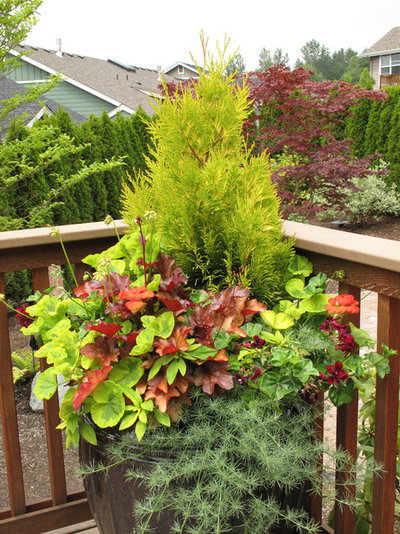
Le jardinet
Golden or chartreuse foliage is so easy to work with in container gardens, and with Forever Goldie arborvitae (
Thuja plicata ‘Forever Goldie’) as the key plant in this exuberant container, the design is off to a great start.
The color scheme has been kept to a simple palette of gold and rust, with annual
geraniums and feathery
lotus vine mingling with the
Peach Flambe coral bells (
Heuchera ‘Peach Flambe’).
In fall the annuals can be replaced by a few winter
pansies and some trailing periwinkle (
Vinca sp) for an inexpensive refresh that takes less than 10 minutes.
Featured conifer: Forever Goldie arborvitae (also called ‘4Ever Goldy’ arborvitae)
Botanical name: Thuja plicata ‘Forever Goldie’
Approximate size of conifer shown: 2-gallon pot
Origin: This cultivar was discovered in the Netherlands in 2002 as a seedling.
Where it will grow: Hardy to -40 degrees Fahrenheit (zones 3 to 7)
Water requirement: Average
Light requirement: Full sun
Mature size: 15 to 20 feet tall and 3 feet wide
When to plant: Year-round
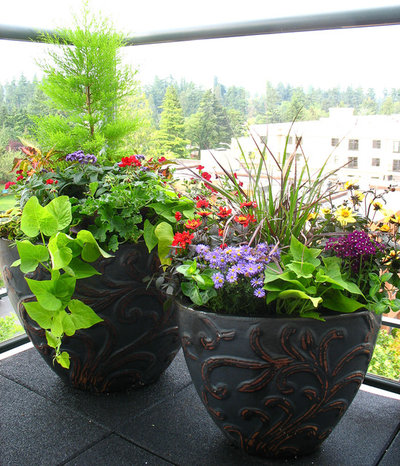
Le jardinet
Transition From Summer to FallThis sequence of two containers shows you how to get a fresh look for summer and fall without the expense of purchasing a new centerpiece. Neither color nor style is compromised. Summer planting is abundant with
swan river daisies (
Brachyscome),
verbena, sweet potato vine and more.
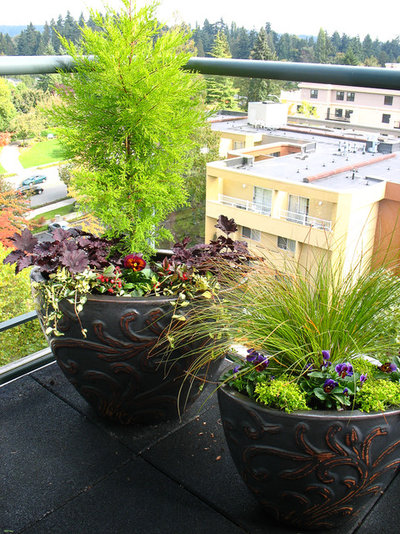
Le jardinet
Fall sees the exchange of summer annuals for winter hardy evergreens and pansies and violas. The same purple, red and chartreuse color scheme is kept, as is the bold conifer.
Tucked beneath the pansies are assorted dwarf spring bulbs, which will add another exciting layer of color to the design.
Featured conifer: Goldcrest Monterey cypress (also called Wilma Goldcrest Monterey cypress)
Botanical name: Cupressus macrocarpa ‘Wilma Goldcrest’
Approximate size of conifer shown: 1-gallon pot
Origin: This was developed in Holland from a genetic mutation discovered in 1987.
Where it will grow: Hardy to zero degrees Fahrenheit (zones 7 to 10)
Water requirement: Average
Light requirement: Full sun
Mature size: Typically to 8 feet tall and 2 feet wide in a container
When to plant: Year-round
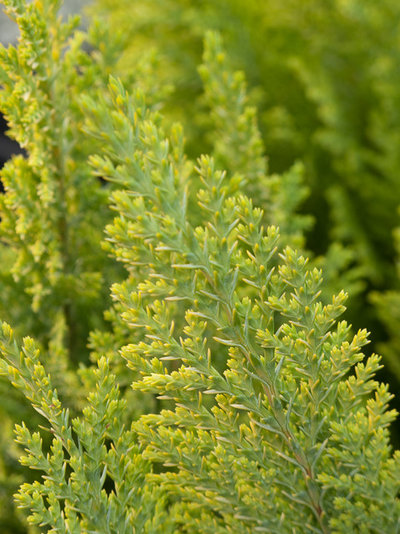
Le jardinet
Planting ConsiderationsThe length of time conifers can live in containers varies enormously and depends upon the type of tree, growth habit, speed of growth, size of container and, of course, the size of the plant you started with. If it is still thriving and the height of the conifer still balances the size of the container, then you can leave it alone. If either of those criteria changes, it is probably time to transplant it, either into a larger pot or into the garden.
It is possible to root prune a conifer carefully to allow you to squeeze in a few small plants around the base, but again there are many factors to consider about whether that would be advisable. If you’re in any doubt, I recommend asking a local nursery professional or specialist container designer for advice.





